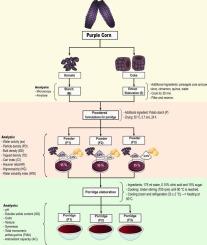天然彩色功能性甜点粉配方:流动性,质地,稳定性和生物活性化合物
IF 4.6
2区 工程技术
Q2 ENGINEERING, CHEMICAL
引用次数: 0
摘要
本研究旨在评估紫玉米粉状配方的理化和流动特性,以及它们在粥状甜点中重组后的颜色、协同作用、质地和生物活性化合物含量。研究了三种配方(F1 = 2.5%马铃薯淀粉+ 2.5%玉米淀粉,F2 = 2%马铃薯淀粉+ 3%玉米淀粉,F3 = 4%马铃薯淀粉+ 1%玉米淀粉)作为紫玉米提取物与水果和香料混合的载体剂。所有粉末均表现出较低的水活度(0.308 ~ 0.342)、中等的吸湿性(11.499 ~ 12.105 gH2O/100 g d.m)和水溶性指数(26.982 ~ 30.319 g/100 g d.m),有利于储存稳定性。攻丝密度结果表明,F3 (0.935 mg/mL)具有较好的压实效果。流动性试验表明,F2的性能最佳(Hausner比值为1.2,Carr指数为16.42%)。当在粥中重组时,样品的颜色参数(L*, a*, b*)与对照相比下降,这与干燥过程中生物活性化合物的损失有关。F3的总单体花青素含量最高,分别为0.360和0.272 mg cya-3-glu/g,抗氧化能力最高,分别为3.118和2.450 mg Trolox/g。所有凝胶都表现出协同作用,这在淀粉基体系中是典型的,但F2表现出最低的协同作用和最高的凝胶强度,表明稳定性得到改善。织构分析表明,温度不可逆转地改变了凝胶的硬度和粘附性,可能是由于淀粉结构的变化。本研究证明了从紫玉米中开发功能性粉状产品的技术可行性,为合成添加剂提供了一种天然替代品,并促进了紫玉米在增值食品应用中的可持续利用。本文章由计算机程序翻译,如有差异,请以英文原文为准。

Naturally colored and functional powder formulation for dessert: flow properties, texture, stability, and bioactive compounds
This research aimed to evaluate the physicochemical and flow properties of purple corn-based powdered formulations, as well as their color, syneresis, texture, and bioactive compound content when reconstituted in a porridge-like dessert. Three formulations (F1 = 2.5 % potato starch +2.5 % corn starch, F2 = 2 % potato starch +3 % corn starch, F3 = 4 % potato starch +1 % corn starch) were developed as carrier agents for a purple corn extract blended with fruits and spices. All powders exhibited low water activity (0.308–0.342), moderate hygroscopicity (11.499–12.105 gH2O/100 g d.m) and water solubility index (26.982–30.319 g/100 g d.m), favoring storage stability. Tapped density results indicated that F3 (0.935 mg/mL) had greater compaction. Flowability tests revealed that F2 showed the best performance (Hausner ratio = 1.2; Carr index = 16.42 %). When reconstituted in porridge, the samples showed decreased color parameters (L*, a*, b*) compared to the control, associated with bioactive compound losses during drying. However, F3 maintained the highest total monomeric anthocyanin (0.360 and 0.272 mg cya-3-glu/g) content and antioxidant capacity (3.118 and 2.450 mg Trolox/g) in both control and reconstituted samples, respectively. All gels exhibited syneresis, typical in starch-based systems, but F2 showed the lowest syneresis and highest gel strength, indicating improved stability. Texture analysis demonstrated that temperature irreversibly altered gel firmness and adhesiveness, likely due to starch structural changes. This research demonstrates the technological feasibility of developing functional powdered products from purple corn, offering a natural alternative to synthetic additives and promoting the sustainable use of this native crop in value-added food applications.
求助全文
通过发布文献求助,成功后即可免费获取论文全文。
去求助
来源期刊

Powder Technology
工程技术-工程:化工
CiteScore
9.90
自引率
15.40%
发文量
1047
审稿时长
46 days
期刊介绍:
Powder Technology is an International Journal on the Science and Technology of Wet and Dry Particulate Systems. Powder Technology publishes papers on all aspects of the formation of particles and their characterisation and on the study of systems containing particulate solids. No limitation is imposed on the size of the particles, which may range from nanometre scale, as in pigments or aerosols, to that of mined or quarried materials. The following list of topics is not intended to be comprehensive, but rather to indicate typical subjects which fall within the scope of the journal's interests:
Formation and synthesis of particles by precipitation and other methods.
Modification of particles by agglomeration, coating, comminution and attrition.
Characterisation of the size, shape, surface area, pore structure and strength of particles and agglomerates (including the origins and effects of inter particle forces).
Packing, failure, flow and permeability of assemblies of particles.
Particle-particle interactions and suspension rheology.
Handling and processing operations such as slurry flow, fluidization, pneumatic conveying.
Interactions between particles and their environment, including delivery of particulate products to the body.
Applications of particle technology in production of pharmaceuticals, chemicals, foods, pigments, structural, and functional materials and in environmental and energy related matters.
For materials-oriented contributions we are looking for articles revealing the effect of particle/powder characteristics (size, morphology and composition, in that order) on material performance or functionality and, ideally, comparison to any industrial standard.
 求助内容:
求助内容: 应助结果提醒方式:
应助结果提醒方式:


